Sky & Deep Sky
South Major Constellations
CARINA - the Keel (of the Argo) - Car
Angular separation Canopus - Eta Carinae = 35°
|
Click on a star name for more informations
| Name | Magn. | Dist. (L.Y.) | Temp.°K | C. | Type | Greek | Const. |
| Canopus | -0.72 | 74 | 7.400 | | F0 | Alpha | Car |
| Miaplacidus | 1.68 | 64 | 9.360 | | A2 | Beta | Car |
| Avior | 1.86 | 79 | 4.440 | | K3 | Epsilon | Car |
| Aspidiske | 2.25 | 299 | 7.800 | | A8 | Iota | Car |
The Carina Nebula is one of the brightest optical emission nebulae in the Milky Way. It stretches over some 2.5 degrees of sky which, at a distance of 8.000 l.y., is 300 l.y. across, about twenty times the size of the Orion Nebula. Two clusters of young stars are primarly responsible for heating the nebula. Each cluster contains one of the brightest known stars in our galaxy. One is HD93129 A, which has a mass estimated to be 120 times that of the Sun and releases most of its five millions solar luminosities as ultraviolet radiation. The second bright star is Eta Carinae.
Eta Carinae, which also is one of the most luminous stars in our galaxy whith a bolometric or total luminosity exceeding 10 40 erg sec -1, emits most of its energy in the infrared. Eta Carinae is today the brightest infrared source outside our solar system observed at wavelengths of 10 and 20 microns. At about 7th magnitude, Eta Carinae is not visible to the naked eye today, but the star brightness has changed by large amounts over the centuries. Halley estimated it ot be 4 times the magnitude observed in 1977. About one hundred years later it was observed to be two magnitudes brighter. During the 1843 it had brightened to magnitude -1 and was the second brightest star in the sky! Eta Carinae remained brighter than first magnitude until 1857, then faded to magnitude 8 by 1900. However, by the late 1970s, it had brightened to mgnitude 6.2. It continues to show slow changes in its brightness.

| Left: the central portion of Eta Carinae Nebula.
Right: The "Keyhole" Nebula.
| 
|
In the small region pictured here are the most luminous stars known in our Galaxy, each brighter than a million sun-like stars. To the bottom left of the picture is Eta Carinae, shrouded in a small bright irregular nebula. In the upper right is a cluster (Trumpler 14) of very young stars which appear to be associated with a number of bright edged "elephant trunk" dust lanes, typical of many star-forming regions.
The other picture shows the "Keyhole" Nebula. This Nebula was first sketched and described by Sir John Herschel in 1838. He noted the circular shell visible in the upper part of the picture extending to the south to form a keyhole-shaped nebula. This southern outline is no longer bright and appears only a dark dust cloud. It seems that, in the years since Herschel's observation, Eta Carinae, to the left of the dust cloud, has buried itself in a cocoon of dust that it ejected, and light from the star is no longer able to illuminate the rim of the "keyhole".
 NGC 3603 & 3576.
NGC 3603 & 3576.
The apparent intimacy of these two star-forming regions is line-of-sight effect because these two objects are at quite different distances from the Sun. The curious looped nebula NGC 3576 is about 7.000 light years from us while its apparent neighbor NGC 3603 is more than twice as far away. That NGC 3603 is the more distant is confirmed by its color, which is ruddier red than the pinkish hue of NGC 3576. The change in color is due to absorption of the blue-light component of the nebulosity by dust particles in the much longer line of sight. This effect is known as interstellar reddening, when it is actually the blue light that is affected.
NGC 3603 is home to a massive star cluster, thick dust pillars, and a star about to explode. The central open cluster contains about 2000 bright stars, each of which is much brighter and more massive than our Sun. Together, radiations from these stars are energizing and pushing away surrounding material, making NGC 3603 one of the most interesting HII regions known. NGC 3603 is about 20,000 light-years away, and the region shown is about 20 light-years across. Possibly most interesting about this recently released, representative-color picture are the large number of dim stars visible. These stars are less massive than our Sun, demonstrating that great numbers of low-mass stars also form in active starburst regions.
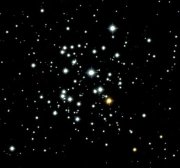 NGC 3293 NGC 3293
Open Cluster
Magn. 4.7
| 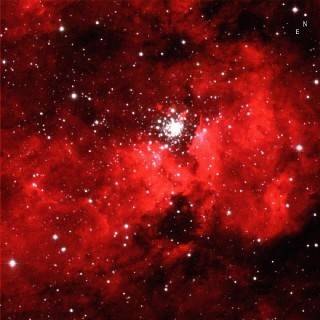 NGC 3603 - particular NGC 3603 - particular
|
CENTAURUS - the Centaur - Cen
Angular separation Menkent - Lambda Cen = 35°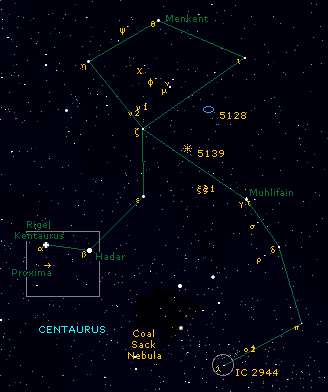 |
| Click on a star name for more informations
| Name | Magn. | Dist. (L.Y.) | Temp.°K | C. | Type | Greek | Const. |
| Rigel Kentaurus A | -0.01 | 4.39 | 5.800 | | G2 | Alpha A | Cen |
| Hadar | 0.61 | 320 | 25.600 | | B1 | Beta | Cen |
| Rigel Kentaurus B | 1.33 | 4.39 | 4.680 | | K1 | Alpha B | Cen |
| Menkent | 2.06 | 50 | 4.800 | | K0 | Theta | Cen |
| Muhlifain | 2.17 | 190 | 9.680 | | A1 | Gamma | Cen |
| Proxima | 10.7 | 4.24 | 2.800 | | M5 | Alpha C ? | Cen |
|
 If humanity looks for intelligent life elsewhere, then Alpha Centauri is an excellent candidate . . .
If humanity looks for intelligent life elsewhere, then Alpha Centauri is an excellent candidate . . .
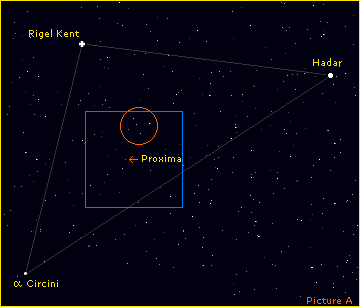
| How to find Proxima from the original
by Doug Brown
|
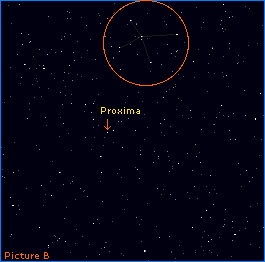
|
With a magnitude of 10.7, Proxima Centauri is exceptional for one reason, it is the nearest star to the Solar System. At about 4.24 light years, Proxima Centauri is marginally closer than the easily identifiable and bright star Alpha Centauri. In space, both stars are separated by about one sixth
of a light year. The question as to whether Proxima Centauri is gravitationally linked to the famous
double star system of Alpha Centauri is not yet fully resolved.
Only after being interested in astronomy for several years did I get around to looking for Proxima
Centauri. When I did however, I found it more difficult than I had thought. To make matters worse, I was unsure whether I had actually observed Proxima Centauri or just some other nearby look-alike reddish/orange star.
Proxima is a well known variable flare star and has been described by Robert Burnham in his Celestial Handbook as possibly one of the most active stars known of its type. Flare stars are usually dim red dwarfs which for some reason, increase and decrease their brightness over a matter of minutes.
As Proxima Centauri is intrinsically around 13,000 times less luminescent than the Sun, any increase in brightness over a short period can often be readily observed. Proxima Centauri has a diameter around 64,000 kilometres or about five times the size of the earth, hence it is a very small star when compared to the Sun. Its a bit like comparing a pea with a large rock melon. To put this into some context, it must be remembered that the Sun itself is considered a dwarf star on the stellar scale.Using the Charts
The two pictures shown here differ in both their scale and limiting stellar magnitudes. Picture A shows
Alpha and Beta Centauri (pointers to the Southern Cross) and Alpha Circinus. The latter is a bright
naked eye star about four degrees from Alpha Centauri in the direction of the South Celestial Pole. Also, Alpha Circinus forms an easily identifiable right angle triangle with the other two stars. Note the asterism shaped like a broken cross marked on the chart.
Picture B is a more detailed map of the immediate region of Proxima Centauri. It should provide enough background stars for the observer to zero in on Proxima Centauri.
To locate Proxima Centauri, I suggest that you first find the cross shaped asterism using Picture A. This should not be too difficult. Now with the help of Picture B, in the direction of Alpha Circinus look for a reddish/orange star about half a degree from the asterism (the diameter of the Moon). Depending on the instrument you are using, Proxima Centauri and the asterism might be in the same field of view. If not, you will need to move your instrument a small amount in a direction towards Alpha Circini.

| 
Particular of the central region |
Centaurus A - NGC 5128
Spiral Galaxy - Magn. 8.0
Dist. 16 mill. l.y.
|
The peculiar radio galaxy Centaurus A (NGC 5128) provides a striking example of how dust can affect our view of a galaxy, and how going to redder wavelengths helps penetrate interstellar dust. This image shows at once the reddening effects of dust in the strong dust lane, some red emission from ionized gas, and blue regions of star formation along the dust lane. The dust blocks most of the light in the blue, and progressively less going through the other wavelengths (and new images deeper in the infrared show even less of the dust). This effect against stars in our own galaxy is known as interstellar reddening, though the effect in galaxies is complicated by the fact that some of the light is not in fact absorbed but scattered in different directions upon encountering a dust grain. Centaurus A is an unusually colorful galaxy; note the very blue star clusters along the edges of the dust lane. This is widely held to be an elliptical galaxy that has acquired a spiral by merger, with the broad and gas-rich dust lane being the most visible debris of the collision. Cen A is also a very strong source of radio emission.
 Omega Centauri - NGC 5139
Omega Centauri - NGC 5139
Globular Cluster - Magn. 3.7 - Dist. 17.000 l.y.
Pictured left is the largest ball of stars in our Galaxy. About 10 million stars orbit the center of this globular cluster - named Omega Centauri - as this giant globular cluster orbits the center of our Galaxy. Recent evidence indicates that Omega Centauri is by far the most massive of the about 160 globular clusters in the Milky Way. The stars in
globular clusters are generally older, redder and less massive than our Sun. Studying globular clusters tells us about the history of our Galaxy and the age of the universe.
 Lambda Centauri Open Cluster
Lambda Centauri Open Cluster
Magn. 4.5 - Dist. 6.800 l.y.
CRUX - the Cross - Cru
Angular separation Acrux - Gacrux = 6° |
| Click on a star name for more informations
| Name | Magn. | Dist. (L.Y.) | Temp.°K | C. | Type | Greek | Const. |
| Mimosa | 1.25 | 460 | 28.000 | | B0 | Beta | Cru |
| Acrux | 1.33 | 510 | 28.000 | | B0 | Alpha | Cru |
| Gacrux | 1.63 | 88 | 3040 | | M3 | Gamma | Cru |
|
 In the southern constellation Crux is a large and nearly starless dark patch just lying in very rich star
fields of the milky way. It is called the "Coal Sack" and can be seen already by naked eye. It is not
really a direction without stars, there is a dark interstellar dust cloud obscuring the light of the stars
behind and so appearing as a dark nebulae. Another well known dark nebulae is the Horsehead nebula.
Another astrophysical effect can be seen in the color image left. There are some extremely red stars
in the northern and darkest part of the Coal Sack. The absorption of red light in interstellar dust is much smaller than that of blue light. So the starlight is reddened by such dust clouds. In the infrared part of the spectrum such dust clouds get nearly transparent. In the optical spectrum such clouds can be detected often just because of this reddening effect. Most of this clouds are not placed so easy visible in front of rich star fields.
In the southern constellation Crux is a large and nearly starless dark patch just lying in very rich star
fields of the milky way. It is called the "Coal Sack" and can be seen already by naked eye. It is not
really a direction without stars, there is a dark interstellar dust cloud obscuring the light of the stars
behind and so appearing as a dark nebulae. Another well known dark nebulae is the Horsehead nebula.
Another astrophysical effect can be seen in the color image left. There are some extremely red stars
in the northern and darkest part of the Coal Sack. The absorption of red light in interstellar dust is much smaller than that of blue light. So the starlight is reddened by such dust clouds. In the infrared part of the spectrum such dust clouds get nearly transparent. In the optical spectrum such clouds can be detected often just because of this reddening effect. Most of this clouds are not placed so easy visible in front of rich star fields.
The Milky Way Near the Southern Cross
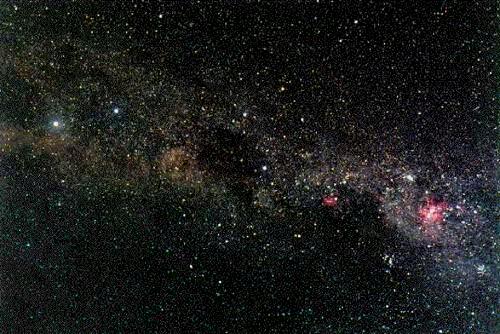 This breathtaking patch of sky would be above you were you to stand at the South Pole of
the Earth. Just above and to the right of this photograph's center are the four stars that mark the
boundaries of the famous Southern Cross. At the top of this constellation, also known as The Crux, is
the orange star Gamma Crucis. The band of stars, dust, and gas crossing the middle of the photograph
is part our Milky Way Galaxy. In the very center of the photograph is the dark Coal Sack Nebula, and the bright nebula on the far right is the Carina Nebula. The Southern Cross is such a famous constellation that it is depicted on the national flag of Australia.
This breathtaking patch of sky would be above you were you to stand at the South Pole of
the Earth. Just above and to the right of this photograph's center are the four stars that mark the
boundaries of the famous Southern Cross. At the top of this constellation, also known as The Crux, is
the orange star Gamma Crucis. The band of stars, dust, and gas crossing the middle of the photograph
is part our Milky Way Galaxy. In the very center of the photograph is the dark Coal Sack Nebula, and the bright nebula on the far right is the Carina Nebula. The Southern Cross is such a famous constellation that it is depicted on the national flag of Australia.

VELA - the Sails (of the Argo) - Vel
Angular separation Suhail al Muhlif - Mu Vel = 26° |
| Name | Magn. | Dist. (L.Y.) | Temp.°K | C. | Type | Greek | Const. |
| Regor | 1.78 | 148 | 30.400 | | O9 | Gamma | Vel |
| Suhail | 2.21 | 330 | 4.320 | | K4 | Lambda | Vel |
| Markab | 2.50 | 430 | 23.200 | | B2 | Kappa | Vel |
 | The Vela Supernova Remnant.
The explosion is over but the consequences continue. About eleven thousand years ago a star in the constellation of Vela exploded, creating a strange point of light briefly visible to humans living near the beginning of recorded history.
|  |
The outer layers of the star crashed into the interstellar medium, driving a shock wave that is still visible today. Different colors in the complex, right moving shock, pictured on the left, represent different energies of impact of the shock front. The star on the left appears by chance in the foreground. Remaining at the center of the Vela Supernova Remnant is a pulsar, a star as dense as nuclear matter that completely rotates more than ten times in a single second.
In the above right optical photograph, the under right corner of the spherical blast wave is shown in detail. As gas flies away from the detonated star, it reacts with the interstellar medium, knocking away closely held electrons from even heavy elements. When the electrons recombine with these atoms, light in many different colors and energy bands is produced.
South Lesser Constellations

Click on a star name for more informations
| Name | Magn. | Dist. (L.Y.) | Temp.°K | C. | Type | Greek |
Const. |
Ab. |
| Al Nair | 1.74 | 101 | 13.600 | | B7 | Alpha | Grus | Gru |
| Al Dhanab | 3.01 | 230 | 12.400 | | B8 | Gamma | Grus | Gru |
| Atria | 1.92 | 105 | 4.560 | | K2 | Alpha | Triangulum Aus. | TrA |
| Peacock | 1.94 | 180 | 23.200 | | B2 | Alpha | Pavo | Pav |
| Kakkab | 2.30 | 580 | 25.600 | | B1 | Alpha | Lupus | Lup |
| Ankaa | 2.39 | 62 | 4.800 | | K0 | Alpha | Phoenix | Phe |
| Persian | 3.11 | 101 | 4.800 | | K0 | Alpha | Indus | Ind |
| Alfecca Mer. | 4.11 | 130 | 9.360 | | A2 | Alpha | Corona Aus. | CrA |
| Polaris Australe | 5.47 | - | 7.400 | | F0 | Sigma | Octans | Oct |
back to top
Constellation pictures are modified screen displaies of Voyager II™ version 2.0 for the Macintosh™, the Astronomy Program of Carina Software, 12919 Alcosta Blvd Suite #7, San Ramon, CA 94583
Go Erectus Home Page
Home Page
| | | Please e-mail to Carlo G. Corti
any suggestion and criticism |
NGC 3603 & 3576.
If humanity looks for intelligent life elsewhere, then Alpha Centauri is an excellent candidate . . .
Omega Centauri - NGC 5139
Lambda Centauri Open Cluster
 In the southern constellation Crux is a large and nearly starless dark patch just lying in very rich star
fields of the milky way. It is called the "Coal Sack" and can be seen already by naked eye. It is not
really a direction without stars, there is a dark interstellar dust cloud obscuring the light of the stars
behind and so appearing as a dark nebulae. Another well known dark nebulae is the Horsehead nebula.
Another astrophysical effect can be seen in the color image left. There are some extremely red stars
in the northern and darkest part of the Coal Sack. The absorption of red light in interstellar dust is much smaller than that of blue light. So the starlight is reddened by such dust clouds. In the infrared part of the spectrum such dust clouds get nearly transparent. In the optical spectrum such clouds can be detected often just because of this reddening effect. Most of this clouds are not placed so easy visible in front of rich star fields.
In the southern constellation Crux is a large and nearly starless dark patch just lying in very rich star
fields of the milky way. It is called the "Coal Sack" and can be seen already by naked eye. It is not
really a direction without stars, there is a dark interstellar dust cloud obscuring the light of the stars
behind and so appearing as a dark nebulae. Another well known dark nebulae is the Horsehead nebula.
Another astrophysical effect can be seen in the color image left. There are some extremely red stars
in the northern and darkest part of the Coal Sack. The absorption of red light in interstellar dust is much smaller than that of blue light. So the starlight is reddened by such dust clouds. In the infrared part of the spectrum such dust clouds get nearly transparent. In the optical spectrum such clouds can be detected often just because of this reddening effect. Most of this clouds are not placed so easy visible in front of rich star fields.